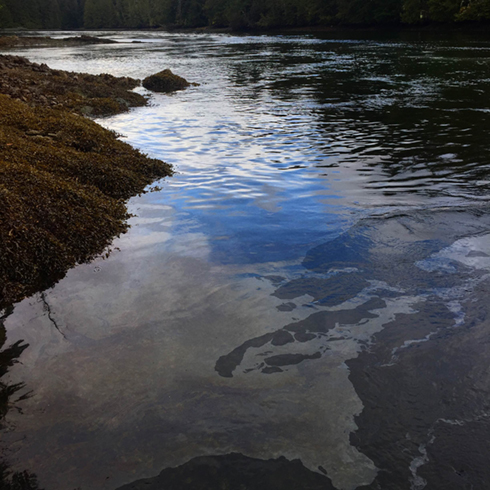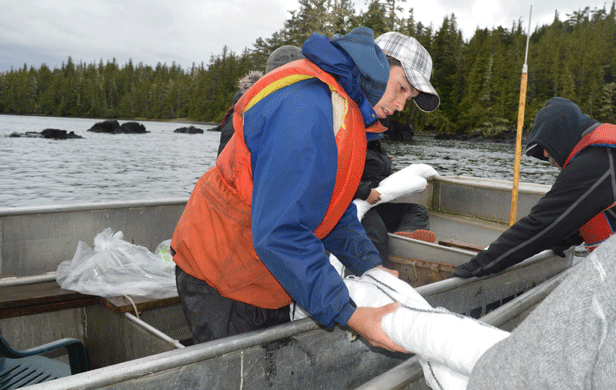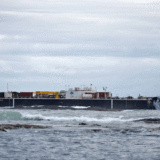
Judging by official statements in the aftermath of the ongoing Central Coast diesel fuel spill, the response to the disaster was relatively effective and damage minimized – a PR line largely soaked up by the mainstream media. To the people in whose territory the incident occurred, the Heiltsuk Nation, and local residents who will have to live with the consequences of the spill, nothing could be further from the truth.
“Recent press seems to suggest that containment efforts have been successful. Let me set the record straight: containment has not been successful, and clean-up efforts have barely begun,” says Heiltsuk On-Scene Commander William Housty. “The damage has been done, and the best we can work towards is mitigation.”
A Heiltsuk media statement this morning drives the point home in measurable terms:
[quote]Only 6,554 gallons of the 59,924 gallons of diesel onboard the tug were able to be pumped from the vessel before it sank in Heiltsuk Territory on the morning of October 13th. Since then, the sunken vessel has been leaking diesel into an area of enormous ecological, economic, and cultural significance to the Heiltsuk Nation.[/quote]

The spill occurred just outside Gale Pass – an important shellfish harvesting site for the Heiltsuk peoples – along with herring spawn on kelp and other fisheries. PR people for the cleanup company, Western Canada Marine Response Corporation (WCMRC), and the company that owns the fuel barge whose tug ran aground and leaked all this fuel, Texas-based Kirby Corporation, have insisted that the contents of the tug, marine diesel, easily dissipate and evaporate, downplaying contamination concerns. If this were the case, then why was Fisheries and Oceans Canada (DFO) compelled to shut down shellfish harvesting for 11 sub-areas around the spill on Friday via an “emergency chemical contaminant closure”?
These PR people have also been quick to counter early concerns about slow response time to the spill. But here are a few key points to consider:
- Initial response came via local contractors for WCMRC, employees of the Shearwater Fishing Resort – and they were not well positioned to respond effectively, according to Kelly Brown, director of the Heiltsuk Integrated Resource Management Department. “The first responding vessels were not equipped to deal with a spill, and had to return to town to gather more gear,” noted Brown, one of the first responders on the scene. “The Heiltsuk are providing our own equipment because what responders have been able to provide so far is insufficient.”
- The main flotilla of response vessels dispatched from Prince Rupert the morning of the spill (which occurred around 1 AM) didn’t reach the site until later that evening
- The tug boat had long since sunk – two thirds of its body underwater, though initially still coupled to the barge – before booms were deployed around it. It doesn’t take a marine engineer to understand that fuel leaking below the surface, amid strong currents and tides, can easily evade booms up above.
- Gale Pass, the entrance to key shellfish waters and beaches, was not adequately boomed until much later, due to strong outflowing currents. Heiltsuk responders who were on the scene expressed in frustration to me that if the booms were deployed earlier, at high tide, they may have remained in place, but with the delay in placing them, they were not able to be properly secured, thus allowing more fuel to make its way up the pass at a critical time.
- No skimming or cleanup efforts began until the day after the spill – initially it was only “contain and protect mode”.
- There were many players involved – Shearwater contractors, Heitlsuk responders, Coast Guard, WCMRC; eventually other contractors brought in by Kirby, Resolve Marine Group and Meredith Management; plus the company’s own Incident Commander, Jim Guidry, along with Federal, Provincial and Heiltsuk incident commanders. Did this contribute to the confusion observed by eyewitnesses on the scene in the early hours of the response? This is something that should be studied for future incidents.
- With all these different players coming and going, the Heiltsuk were left to carry much of the load themselves – which they did admirably, according to many of the players involved, much like their Gitga’at neighbours to the north were forced to do in the wake of the sinking of the Queen of the North a number of years ago.
- We still don’t know the official cause of the incident. Was it mechanical or instrument failure? Did human error play a role? The tug and barge appear to have gone wildly off-course for a number of miles. Did the captain fall asleep at the wheel? Why did his co-pilot not take control? Or did he not even have a co-pilot? We know this American company was given a waiver exempting it from having a pilot on board from the Pacific Pilotage Authority – since revoked in the wake of this incident, according to Federal Transport Minister Marc Garneau. Why did it take such a disaster for this to occur? Why was the waiver issued in the first place? We need answers to these questions asap.
Long after the incident command is dismantled and the media loses interest in the story, the Heiltsuk and central coast residents will still be dealing with the consequences of this spill.

“The Heiltsuk are heartbroken and angry over this environmental disaster. We don’t know how many years or decades it will be before we are able to harvest in these waters again,” said Chief Councillor Marilyn Slett.
“Yet our community members are heroic. The overwhelming majority of vessels out on the water are Heiltsuk volunteer crews. Our community members are doing their best to assist with response efforts, but have not been receiving adequate direction or training from the Western Canada Marine Response Corporation in charge of the clean up.”
Bear in mind that despite these serious impacts to shellfish grounds and other natural resources, matters could have been much, much worse, had the fuel barge the tug was towing been full instead of making its return trip from Alaska to a southern port for refuelling.
This is why the Heiltsuk are calling for this incident to spur a long-discussed north coast tanker ban which the Trudeau government has yet to act upon. “We must take note, however, that tanker barges like this might not even be included in the ban. The ban needs to be complete, and spill response must be improved,” a recent statement noted.
In contemplating this ban, the Trudeau government would do well to ask itself: why does such a vessel need to take the inside passage? Why not direct it further west on the outer coast, avoiding the myriad navigational hazards, communities and sensitive ecological areas of the inner coast?


One possible error in your otherwise very good article. I think I read somewhere that the skimming equipment was not scheduled to begin until Monday, Oct 17. I may have misread your article or misinterpreted the date in other reports. Yes, I agree that the official reports have been whitewashing the reality with positive pleasant sounding words like effective, contained, minimize. This is what the shipping industry is good at, whitewashing and cheerleading. The Transportation Safety Board of Canada is looking into the incident and has issued some twitter comments but they have not yet committed to a full blown investigation. I expect the only way we are going to find some truth and closure is if there are lawsuits against Kirby and against the Pacific Pilotage Authority. The PPA waiver looks on the surface like a permanent waiver with no ongoing verification, no requirement to reapply and requalify. If it applies to a crew or to a boat surely there are staff changes, boat issues, various changes that would nullify the waiver. Is this the first ever waiver to be revoked? The waivers for these specific tanker barges are stupid in the first place, the consequences of failures are just too huge and after-event mitigation, as we are again witnessing, is pitiful. I can guarantee you that there is inadequate insurance coverage for even this event and most certainly for bigger ones. The risk
analysis must include impact and worst case, not just probabilities of a spill of size X every Y years. The PPA waiver process should be thoroughly reviewed and these tanker barges should be immediately banned from Canada’s inside passage.
Hi Ted, I said “not until the following day” – meaning the day after the spill, a.k.a Saturday Oct. 15. Perhaps I could have been clearer. I have amended the piece to include that detail more clearly spelled out.
dear salal, i think you are being too nice. we are owned by the hidden hand of corporations, and their bought politcians. The common people mean nothing in the face of greed, except as a tax base and consumers,
There is a tide every 6 hours. A ‘world class’ spill response requires all the equipment and personnel to be onsite and working within those first 6 hours. In this case, it is reported that the equipment came from Prince Rupert, 24 hours away. The people from Bella Bella were there very soon after the grounding occurred, but they were there with their own resources. Their own resources being mostly fish boats, probably with an average size of 40′.
World class for a small non tidal lake.
A super tanker will leave us with a much larger present. Justin will confer with Christy and they’ll both, in unison exclaim the same meaningful word….oops! We are being governed by…oops.
No .
Not “oops”
Christy will be governed by “ops” also known as “Photo ops”
Never under estimate the ability of a politician to spill “good” out of “bad”